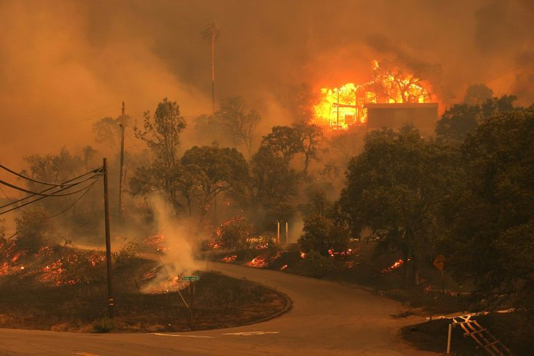
LOS ANGELES, Aug 21 (NNN-AGENCIES) — A series of massive fires in northern and central California forced more evacuations as they quickly spread Thursday, darkening the skies and dangerously affecting air quality.
The blazes, most of which were touched off by a rash of lightning strikes
earlier in the week, are concentrated to the north, east and south of San
Francisco and are being fed by a grueling heat wave afflicting the state
along with low humidity.
Evacuation orders were expanded in several counties overnight as the flames devoured homes, forced the shutdown of roads and heavily damaged California’s oldest state park.
Officials said some 60,000 people had been evacuated and 100,000 more were under evacuation warnings.
“In the past four days, there have been over 370 new wildfires and nearly
two dozen of those major fires are still burning across California,” said
Daniel Berlant, Cal Fire’s assistant deputy director in an update Thursday
afternoon.
Authorities said the fires had consumed nearly 350,000 acres in the central and northern part of the state, including in the wine regions of Sonoma and Napa, which are still recovering from other deadly, devastating fires in recent years.
“2020 has thrown a lot at us. A pandemic. Lightning strikes. Record heat
waves. Fires. But if there’s one thing I know about CA it’s that we are
resilient,” Governor Gavin Newsom, who has declared a state of emergency to free up funds to battle the flames, said in a tweet Thursday.
One of the largest groupings of fires — known as the LNU Lightning
Complex, which encompasses Napa and Sonoma Counties — grew to 131,000 acres Thursday and was zero percent contained.
Cal Fire officials said the many blazes of the LNU Lightning Complex had
begun to merge together to create a massive inferno.
“This is a very large fire. It’s one of many in the state of California and
honestly our resources are stretched very far,” Cal Fire unit chief Shana
Jones said.
The complex of fires has already destroyed 105 homes and structures and is
threatening more than 30,000 other buildings, fire officials said.
Two people taking part in the firefighting efforts have died. One was a
helicopter pilot who was killed in a crash in Fresno County, southeast of San
Francisco, as he was attempting to drop water.
The second was an employee of the utility company Pacific Gas and Electric
(PG&E) who was clearing poles and electrical lines and was found unresponsive in his vehicle Wednesday, Cal Fire said.
Meanwhile southeast of San Francisco, another grouping of fires dubbed the SCU Lightning Complex grew to nearly 137,500 acres by late Thursday afternoon and was just five percent contained.
In Santa Cruz County, closer to the coast, a series of fires called the CZU
Lightning Complex caused extensive damage to California’s oldest state park, Big Basin Redwoods State Park, known for its majestic redwoods that are up to 2,000 years old.
“The fire damaged the park’s headquarters, historic core and campgrounds,” park officials said.
More than two dozen other parks and beaches in the region were shut down because of the wildfires.
Authorities have said the fires — grouped together and identified through
three-letter monikers because of the high number of blazes across many
counties — were caused by nearly 11,000 lightning strikes that hit the
northern half of the state as it bakes under historic high temperatures,
including a record of 130 degrees Fahrenheit (54.4 degrees Celsius) in Death
Valley.
Experts believe climate change has contributed to the frequency of the
fires, which are becoming more common year-round rather than just during fire season — usually between August and November.
The latest fires have prompted air quality alerts, with the air over the
Bay Area expected to be extremely poor in the coming days.
“As many of these fires will burn for days–even weeks–air quality will be
extremely poor for an extended period,” Daniel Swain, a climate scientist at
the University of California Los Angeles (UCLA), said in a tweet.
Temperatures were expected to cool slightly over the weekend, providing a
reprieve for firefighters.
The deadliest fire in the state’s history — the Camp Fire — took place in
northern California in November 2018 and killed 86 people.
Fires were also raging Thursday in several other western states including
Washington, Colorado and Montana. — NNN-AGENCIES






